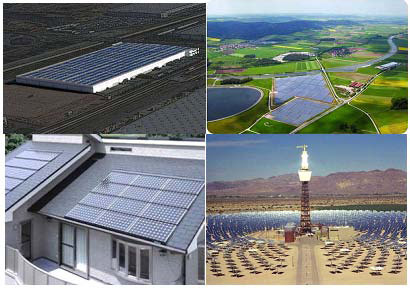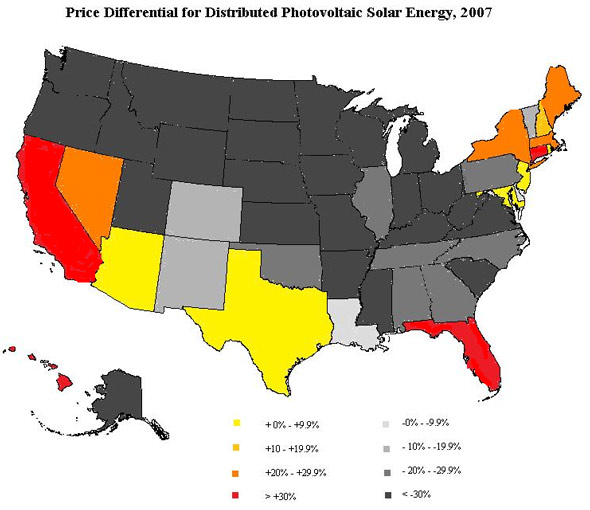The Economics of Small Solar Energy Systems: Distributed Solar and Grid Parity
Small Solar Energy Systems Can Be Cost Competitive in Many Parts of the Country
Distributed solar energy systems are small scale (usually smaller than 2 megawatts) photovoltaic installations that are built near their point of use. In light of recent national dialogue regarding climate change and energy independence, there has been a push for utility companies to incorporate these small scale projects into their energy portfolios. Whether these companies decide to adopt distributed solar is largely contingent on its economic fitness compared to traditional energy sources, including coal, natural gas, and nuclear power. While the solar industry faces challenges, this study found that distributed solar energy systems are cost competitive in states with high retail energy prices and high solar radiation rate.
Distributed solar energy systems have a number of important advantages over centralized fossil fuel plants and large scale solar farms. First, installing solar panels requires a less sophisticated grid system than building a large power plant. Since each panel is installed at the point of use, distributed systems do not require the additional installation of costly high tension transmission lines, and their use can reduce traffic in local distribution wires. According to the Energy Information Administration, about 6.5% of generated energy is lost in transporting power from a centralized generating station to an end user.
Distributed generation also has environmental benefits over utility scale plants and fossil fuel sources. Small scale solar installations require a smaller geographic footprint than centralized power plants and, consequently, face fewer land use restrictions. Furthermore, solar modules are emissionless, release fewer chemicals into the environment, and are far less polluting than coal plants.
Challenges for the Distributed Energy Industry
The goal of the distributed solar industry is to become cost competitive with traditional energy generating sources, like coal and natural gas. While distributed solar power systems have distinct advantages over these technologies, there are a number of challenges that the industry must address before gaining widespread appeal. First, distributed photovoltaic panels require a higher capital investment per kilowatt of generating capacity than coal and solar thermal plants. The Energy Information Administration estimates that distributed generation can cost as much as 70% more to install than coal capacity.
In addition to the cost premiums, distributed photovoltaics generate electricity intermittently. Solar energy is most available during the afternoon, making solar panels more productive during the day than during the dark evening hours. Similarly, solar technology generates more electricity in the summer than during the dark winter months. While peaks in solar energy production usually correspond with peaks in consumption (energy loads are highest during the day when air conditioners and televisions are running), intermittency issues reduce the reliability of the electricity grid. Coal power plants, on the other hand, produce consistent and predictable energy streams that offset the intermittency of renewable generation.
Achieving Grid Parity
Grid parity is the point when an energy generating technology can produce electricity at or below the selling cost of grid power. Currently, the cost of producing solar energy on large photovoltaic farms is higher than the average market cost of electricity to consumers. Consequently, the demand for solar power is much lower than the demand for coal or natural gas, which can produce inexpensive electricity. Many analysts believe that if solar energy can reach grid parity, its demand will increase significantly in the United States.
The most effective way to assess the competitiveness of different generating technologies is to perform a levelized cost analysis. This method discounts future cash outflows over the expected lifetime operation of an energy facility to a common point in time. The result is then reported in units of dollars per kilowatt-hour of energy. The convenient notation allows investors to easily compare revenue generating potential of different energy technologies. The levelized cost method uses three important variables: the capitalized cost of constructing a power plant, the annual fuel and maintenance costs incurred from plant operation, and waste management expenses. A levelized cost comparison for four different technologies (coal, distributed photovoltaics, centralized photovoltaics, and solar thermal) reveals that distributed solar energy systems, particularly in high solar radiation states like Arizona, are more cost effective than photovoltaic solar farms and solar thermal facilities. The cost of producing electricity from distributed generation in Arizona is about 7.94 cents per kilowatt-hour. Solar thermal plants and centralized photovoltaic farms produce electricity at 8.89 cents per kilowatt-hour and 28.6 cents per kilowatt-hour respectively. Energy from centralized coal plants was the least expensive with a per kilowatt-hour cost of 5.39 cents.
The average cost of generating electricity through distributed energy sources (7.94 cents/kWh) is less than the average selling price of electricity to consumers (9.13 cents/kWh). This suggests that on average, utility companies can generate a profit using distributed solar technologies. The issue becomes even more interesting if you split the profit generating potential of distributed solar energy by state. Using average insolation rates from around the country, the levelized cost of distributed photovoltaic energy systems can be determined for each state. Not surprisingly, southern states, like Arizona and New Mexico, fare best in this cost analysis. Their relative proximity to the equator means that they are radiated with more solar energy than northern states. Northeastern states, like Connecticut, New York, Massachusetts, and Vermont have the highest levelized cost for distributed energy.
The levelized energy cost can be compared with the average retail price of electricity to consumers. Figure 1 below shows the margin between the cost of producing energy and its price to consumers. In the colored states, the costs of electricity from distributed energy systems is less than the price to the consumer. In the red states, for example, the price per kilowatt-hour to the consumer is more than 30% higher than the cost of generating a kilowatt-hour with a distributed solar energy system. This means that utility companies in these states can make a profit if they implement distributed generating systems. Conversely, in the gray states, the cost of producing electricity from distributed solar is higher than the cost of electricity to the consumer. In the absence of a robust incentive program, distributed photovoltaics would lose money in these states.

Figure 1: This map shows the price differential between generating electricity with distributed photovoltaics and the average retail price of electricity to consumers. A red state indicates that the price of electricity is 30% higher than cost of generating electricity in that state.
The analysis shows that the northeast and southwest are most cost effective for distributed solar energy systems in the United States. Although the northeast has low solar radiation levels, the high cost of electricity in these states would make an investment in distributed energy profitable. In California and Hawaii, a combination of high insolation rates and high energy prices make distributed power very attractive compared with other forms of electricity generation.
There are a number of important considerations to make when evaluating the levelized cost analysis outlined above. First, the cost analysis above does not account for state incentive programs. The financial incentives for solar energy systems differ by state and year. Some states, like California and Arizona, have progressive regulations that vigorously promote the adoption of solar energy. Other states, like Wyoming and Idaho, do not incentivize solar energy. A more complete financial analysis would account for the per kilowatt-hour rebate provided by different state incentive programs.
Finally, the levelized cost analysis uses data from 2007. While this is the most recent available data from the United States Energy Information Administration for energy costs and retail prices, the economic climate of the American energy market has changed considerably since 2007. Financial investment companies endured a deep recession and consumer spending went through peaks and troughs. Assessing the implications of these changing economic conditions would be difficult to simulate without more recent data. Moreover, technology for photovoltaic panels has improved substantially since 2007. Incremental improvements in efficiency would likely reduce the price of distributed energy systems even further.
Distributed Solar Energy Becoming More Cost Competitive
While distributed solar photovoltaics require a higher initial investment than comparably sized fossil fuel plants, the lifetime costs of operating a distributed energy system is becoming more and more cost competitive. This is particularly true in states with substantial solar resources or high electricity prices. Though grid parity may be a long way away in states like Idaho and Wyoming, other regions of the country may begin to adopt solar energy systems much sooner. Constant improvements to photovoltaic solar technology and increasing awareness for environmental issues may push distributed solar energy systems further into mainstream energy markets in the coming decade.
